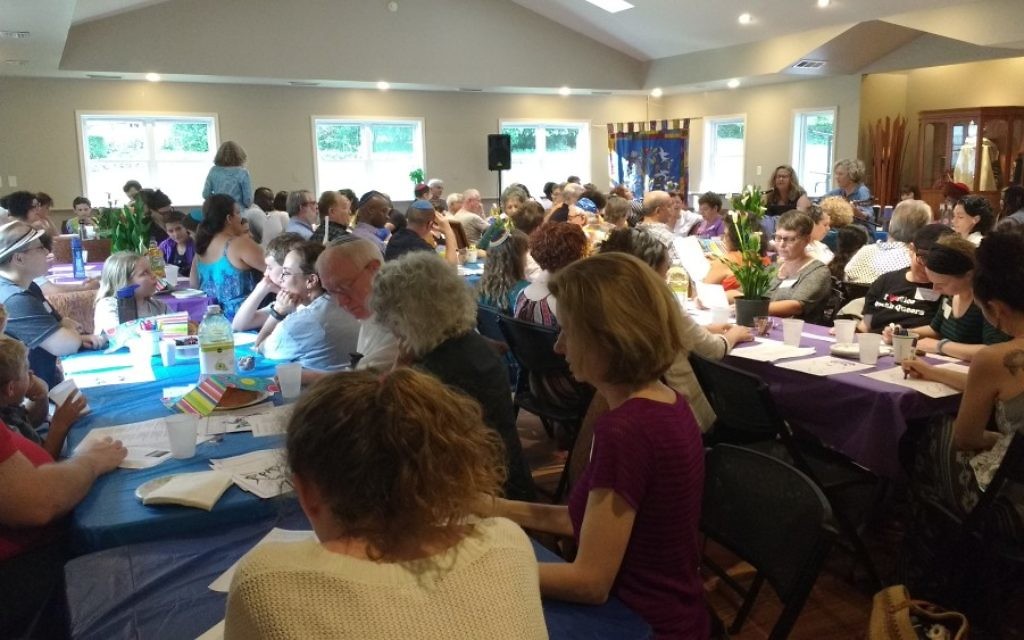Pride Seder Uplifts Amid Mourning

Above: More than 100 people attend the Pride Seder on June 24 at Congregation Bet Haverim.
Atlanta’s Pride Seder, an annual part of Pride Month, was scheduled for Friday, June 24, long before 49 people were gunned down at a gay nightclub in Orlando, but the massacre at Pulse on June 12 made the seder all the more meaningful for the more than 100 people who attended.
The event was held just two days before the first anniversary of the landmark Supreme Court decision legalizing same-sex marriage across the United States, but the Pulse massacre was a reminder that the LGBTQ community still has reason to feel threatened in this country.
Get The AJT Newsletter by email and never miss our top stories Free Sign Up
LGBTQ Americans, including Jews, for decades have been institutionally and legally discriminated against, harassed, abused, marginalized and essentially forced to live as second-class citizens.
In recognition of the need for inclusivity and for collective healing, Congregation Bet Haverim played host to the Pride Seder to remember the recent victims, celebrate past challenges and victories, and honor the LGBTQ community in general.
Adding symbolism, the seder was hosted by a congregation founded by gay men in a building previously used by an Orthodox synagogue, Young Israel of Toco Hills.
Each place setting had a fun activity people could fill out individually: a “gender unicorn” showing the possible spectrum of gender identity. On the opposite side of the page was a blank outline of a gingerbread person to be filled in as you see yourself: male, female or other.
Shortly before the Shabbat candles were lighted, Gayanne Geurin and Melanie Hammet sang a song recently written by LGBTQ activist Melissa Etheridge honoring the nightclub’s victims, titled “Pulse.”
Co-facilitated by Rabbi Joshua Lesser of CBH, Rabbi Malka Packer of InterfaithFamily/Atlanta and SOJOURN, much of the evening was led by members of Bet Haverim’s LGBTQ Teens and Allied Teens.
Some of the participants spoke about their own experiences and struggles. One young woman’s story was especially poignant: She identifies as a “queer African-American Muslim” who grew up in Orlando, and she was personally affected by the shooting June 12. Attending the seder was an opportunity to feel safe and welcomed, she said.
Teenager and Bet Haverim congregant Mattie Laing helped lead the actual seder, which was strong in symbolism and emblematic of LGBTQ rights struggles. Linking the overarching Passover theme of freedom and justice to that of the LGBTQ community, the seder plate itself (set on the teens’ table) held seven symbols, correlating to the seven colors on the famous Pride flag created by artist Gilbert Baker in the 1970s.
Baker was commissioned to design the flag by his friend Harvey Milk, the Jewish political activist and first openly gay American elected official.
Seder attendee Jessica Ozar said: “It was very powerful listening to the teens, and their experiences and stories made me think about the variety of experiences and differences we have. It is great to see that there is a group of teens that can comfortably come together.”
The seder included a version of the Four Questions specific to the evening’s themes, and the Maggid, the telling of the story, retold the story of Stonewall, the watershed uprising that saw gay rights become more prominent nationally. Coincidentally, President Barack Obama named the Stonewall Inn a national landmark a few hours before the seder.
“I got chills during the Maggid portion of the seder as we shared the story of my queer ancestors at Stonewall,” Rabbi Packer said. “I was also deeply moved as queer youth from our community stepped into their power. They shared their strengths and concerns of the next generation.”
When the Ten Plagues were read aloud, complete with dipped fingers, they focused on humanity’s plagues of discrimination, oppression, family rejection, homophobia, suicide, and other pernicious, man-made societal afflictions.
The Concluding Prayer was simultaneously inward-focusing and outwardly affirming. In part it reads, “Source of Life … the brilliance of our spirits gives us hope and strength to live with integrity, true to our mind and hearts. … We feel Your presence … guiding us to claim our rightful place in our rich Jewish tradition and culture. We have come together to choose life, to choose blessing, and to experience the grace of being whole and at peace.”
Photos by Benjamin Kweskin





comments